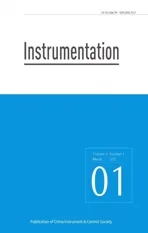Target Path Tracking Method of Intelligent Vehicle Based on Competitive Cooperative Game
2022-08-19SONGChongzhiNIULimin
SONG Chongzhi, NIU Limin
(Engineering Research Institute, Anhui University of Technology, Maanshan, 243002)
Abstract: To improve intelligent vehicle drive performance and avoid vehicle side-slip during target path tracking, a linearized four-wheel vehicle model is adopted as a predictive control model, and an intelligent vehicle target path tracking method based on a competitive cooperative game is proposed. The design variables are divided into different strategic spaces owned by each player by calculating the affecting factors of the design variables with objective functions and fuzzy clustering. Based on the competitive cooperative game model, each game player takes its payoff as a mono-objective to optimize its own strategic space and obtain the best strategy to deal with others. The best strategies were combined into the game strategy set. Considering the front wheel angle and side slip angle increment constraint, tire side-slip angle, and tire side slip deflection dynamics, it took the path tracking state model was used as the objective, function and the calculation was validated by competitive cooperative game theory. The results demonstrated the effectiveness of the proposed algorithm. The experimental results show that this method can track an intelligent vehicle quickly and steadily and has good real-time performance.
Keywords: Intelligent Vehicle, Target Path Tracking, Competitive Cooperative Game, Model Predictive Control
1 Introduction
The research on the key technology of intelligent vehicle is a hot research topic at home and abroad, in which path tracking refers to the core technology of safe, accurate, and stable driving of intelligent vehicles along the present highway, and the strength of its performance plays a decisive role in the driving stability of intelligent vehicles[1]. For path tracking at limits of handling, there still is a enormous challenge to guarantee the tracking performance because the tire cornering characteristics show high nonlinearities and uncertainties under those special driving conditions[2-4].
To enhance the performance of path tracking,domestic and foreign scholars have adopted a variety of research strategies, such as applying the four-wheel robot path tracking method to intelligent vehicle target tracking, pure pursuit method was adopted in reference[5], the geometric shape method of circular look-ahead for tracking was adopted in reference [6], because of the constraints of vehicle size, driving condition,turning radius and driving dynamics, the pure geometric path tracking method is not able to solve the driving constraint problem of intelligent vehicles. At present, the model control strategy is often used to study the high precision control of intelligent vehicle path tracking, on the basis of the deviation of vehicle position, course, target path, an incremental PID control algorithm was adopted[7], reflecting better path tracking performance. The linear time-varying model predictive control strategy is used to transform the three-DOF dynamic model into two programming problems, and the simulation results show that the control strategy not only has high accuracy of path tracking, but also has good driving stability in the middle and low speed[8]. Reference [9] established a feedback fuzzy controller by using the feedback prediction error method and achieved good simulation results when the vehicle speed was less than 60km/h.
The performance of path tracking is related to the driving condition and driving parameters of the vehicles, and all parameters are interconnected. Under the condition of normal driving, how to cooperatively calculate the interconnection between parameters and realize the high-precision control of intelligent vehicle path tracking is the focus of current research. Some research achievements have been made in solving multi-objective control by game theory. Nenggang[10-12]et al. successfully applied game theory to engineering design and gave the key solving techniques of game theory in multi-objective decision-making, the formulation of game rules, and the division and solving steps of the strategy space of each player. In the target game method, the design variables of the system are mapped to the spatial strategy sets that can be selected by each player through fuzzy cluster analysis. Combined with the mutual relations among the players in the game:the strategic relations of competition, cooperation,and coordination, the rules of the game are different according to the different selection relations in the game, to realize the individual benefits and the overall benefits of the players. It adapts to the environment and satisfies the game constraint conditions through the mutual relations among the game participants, and then realizes the balance, stability and harmony among the multiple objective functions. Combined with the constraint relations among the front wheel deflection angle, the incremental constraint of the side deflection angle, and the dynamics of the tire side deflection angle, the path tracking state model in the time domain was taken as the objective function, and the joint simulation was carried out by using FORTRAN and MATLAB. The simulation results show that the algorithm is effective. Combined with the experimental vehicles, the experimental results show that the method can quickly and stably track the intelligent vehicles, the range deviation and the azimuth deviation are within a reasonable range with a good real-time performance. It provides a new method for intelligent vehicle target path tracking.
Combined with the competitive cooperative game,this paper presents a path tracking method for intelligent vehicles based on competitive cooperative game by using the linearized four-wheel vehicle model as the path tracking control model. Combined with the constraint relations among the front wheel deflection angle,the incremental constraint of the side deflection angle,and the dynamics of the tire side deflection angle, the path tracking state model in the time domain was taken as the objective function, and the joint simulation was carried out by using FORTRAN and MATLAB. The simulation results show that the algorithm is effective.Combined with the experimental vehicle, the experimental results show that the method can track the intelligent vehicle quickly and stably, the range deviation and the azimuth deviation are within a reasonable range, and has a good real-time performance. It provides a new method for intelligent vehicle target path tracking.
2 Path Tracking Control Model
2.1 Establishment of Vehicle Dynamics Model
Ignoring the air resistance of the intelligent vehicles, the contact between the tire and the ground is assumed to be the point contact, the front wheel deflection angle is small, and there is no relative sliding,combined with the reference [13], the paper uses the four-wheeled vehicle model as shown in Fig.1, In the figure, XOY is the road surface coordinate system, xoy is the local coordinate system of smart car, and it is stipulated that the X-axis is the vehicle driving direction.
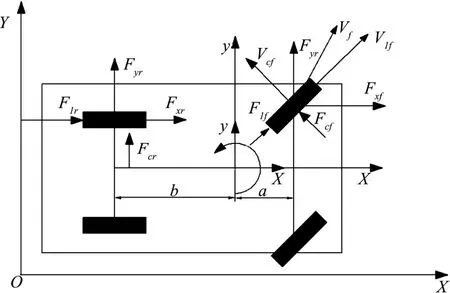
Fig.1 Dynamics of Four-wheel
The kinematics equation of the intelligent vehicle around the x-axis direction is:

The lateral kinematics mechanics equation around the y-axis direction is:

The transverse oscillation equation around the zaxis direction is:

Where m is the mass of the vehicle, a and b, respectively, represent the distance from the center of mass of the vehicle to the front axle and rear axle, Izis the moment of inertia of the vehicle, θ is the heading angle of the vehicle, Fxfis the X-axis force on the front wheel of the vehicle, FxrIs the X-axis force on the rear wheels of the vehicle; Fyfis the X-axis force on the front wheel of the vehicle, FyrIs the X-axis force on the rear wheels of the vehicle.
Combined with the basic principles of horizontal pre-aiming error and path tracking error [14], to organize (1), (2), and (3), the nonlinear dynamic model was obtained under the condition that the front wheel deflection angle is small:

In the formula, Cefis the lateral deflection stiffness of the front wheel of the vehicle, Ceris the longitudinal stiffness of the rear wheel of the vehicle; Clfis the longitudinal stiffness of the front wheel of the vehicle, Clris the lateral deflection stiffness of the rear wheel of the vehicle; σfis the front tire deflection angle of the vehicle; sfis the slip rate of the front wheel of the vehicle, sris the slip rate of the rear wheel of the vehicle.
Intelligent vehicle path tracking has strong real-time performance, the nonlinear dynamic tracking model is difficult to achieve real-time control, so formula (4) is linearized.,where ξ is a state variable,, whereuis a control variable, u =σf, we can get:

2.2 Model Output Equation

2.3 Construction of Model Constraints
The manipulation stability directly affects the riding comfort, so in addition to the dynamic constraints, this paper also increases the wheel deflection angle, the side deflection increment constraint, and so on, to ensure the driving stability and comfort of the intelligent vehicles.
Front wheel deflection angle and its incremental constraint: when the tire deflection angle is less than 5°,there is a linear proportional relationship between the lateral deflection force and the lateral deflection angle,and the lateral deflection angle selection range of this paper is: -2°≤ δ ≤ +2°. According to the physical position of the intelligent vehicles, in the range of deflection angle change at any time, the deflection angle and the incremental constraint can be expressed as:
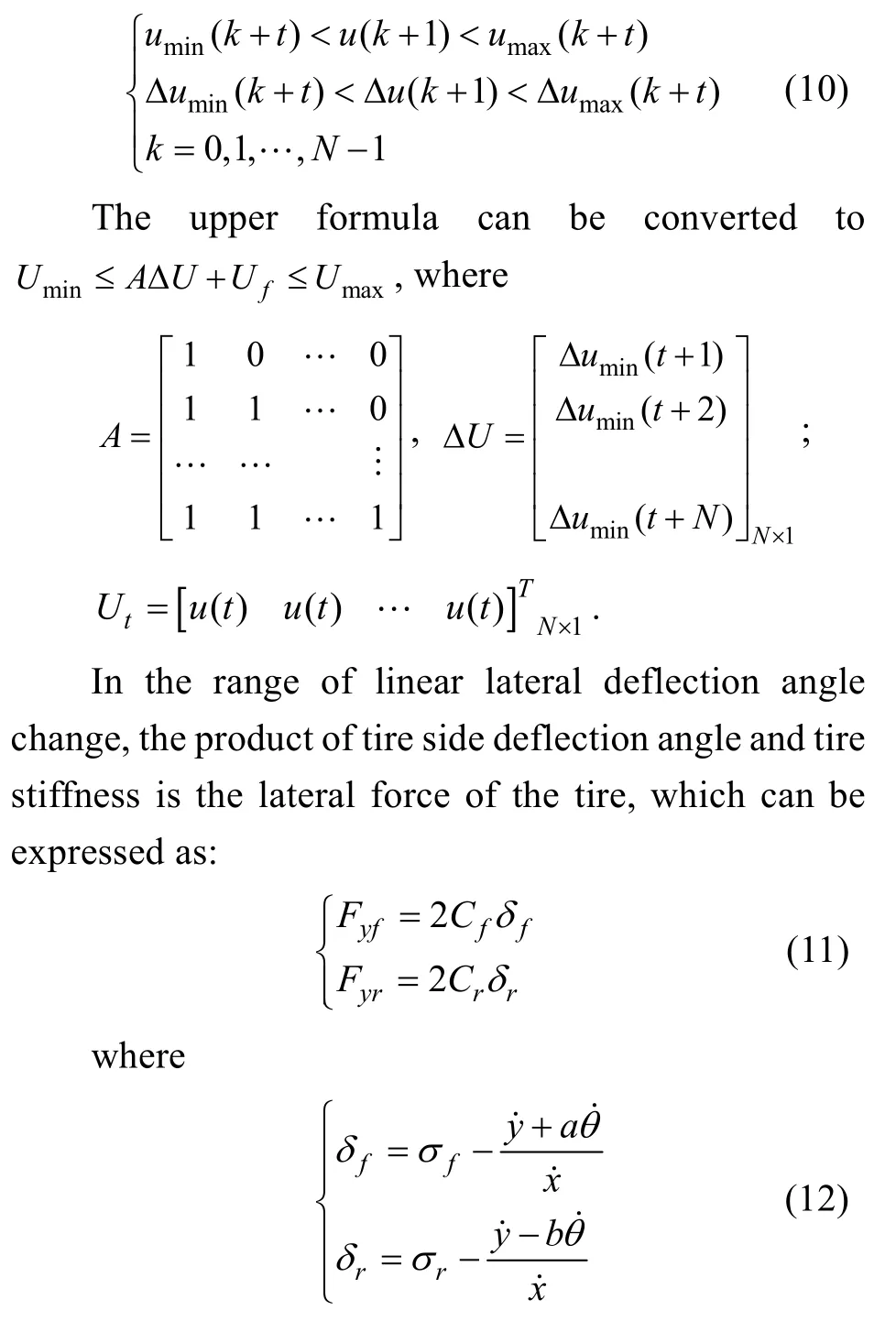
δris the rear wheel deflection angle of the vehicle,σf, σrare the front and rear rotation angle.
Take u, ξ as the control quantity and the state quantity, respectively, formula (12) is linearized, which can obtain

2.4 Construction of Model Predictive Controller
Considering the complexity of the vehicle driving process, when designing the objective function, the relaxation factor is introduced, and the tracking objective function can be expressed as

Synthesize constraints and objective functions,the intelligent vehicle path control controller based on dynamic model can be transformed into optimization problem, that is, each cycle needs to be resolved:

3 Multi-Objective Control Methods Based on Competitive Cooperative Game
3.1 Problem Description [15-16]
The multi-objective solution problem is described as

In the formula: n is the number of multi-objective optimization design variables; m is the number of objective functions; q is the number of constraints; Ωnis the feasible domain for the set of optimization design variables.
A game problem is composed of three parts,namely: game side, game side income and the corresponding game strategy. In the game problem G, the number of all participants in the game is expressed as m,then the overall game strategy space can be expressed by S1, S2,… ,Sm; sij∊ Sirepresents the jth strategy in the strategy space of the ith player. The corresponding revenue was expressed by ui.
When solving the optimal problem, the variables involved are not only one, but when the game method is solved, the mapping relationship between the game side and the design variable should be established first,and the optimal problem can be expressed as the game method:
1) Establishing the mathematical model, design variables, objective function, and corresponding constraint conditions of the problem to be solved
2) The mapping relationship between the game square and the objective function is established, the design variable and the game side one by one correspond, and the strategy set of the whole game side is solved. S ={S1, S2,… ,Sm}; Divide the set of design variables into the policy space of each game side:S1={xi, …, xj}, …, Sm={xk, …, xj}, and meets S1∪ L ∪ Sm=X , Sa∩Sb= 0 .
3) By transforming the constraint conditions of multi-objective optimization function of various game participants to choose the policy space constraint condition through the fuzzy clustering method, the problem to be solved can be transformed into the solution of the corresponding game G={S1… Sm; u1… um}.
The essential difference between the cooperative game (Cooperation game) and the non-cooperative game (non cooperation game) is that each game par-ticipant agrees with each other: any game party must abide by the cooperative constraint agreement based on the cooperation agreement.
In the model of competitive cooperative game proposed in this paper, the proposed constraint agreement for all game participants is: “do things harmful to others without benefiting oneself”, that is,to any game player, in the pursuit of the maximization of their own interests, must not harm the returns of other game players; when a single game player adopts a game strategy, its own return is defined as absolute returns, which is defined as ui. Return that relative to other players were defined as relative returns, which was defined as(j=1 ,… ,i-1 ,i + 1,…,m ).
Competitive cooperation strategy: the strategy space of each game player is screened, and the policy spaces that conform to the selection are combined into a strategy combination{s1, s2,… ,sm}, for any game side, if i the alternative strategy s*isatisfies:
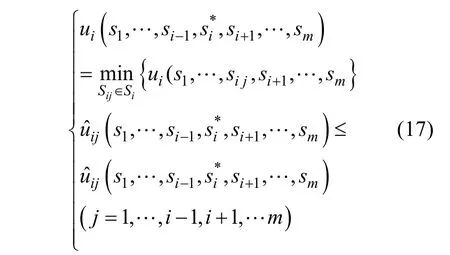

3.2 The Solving Steps of Competitive Cooperative Game
1) Single objective optimization is carried out for the m objective functions, and the optimal solution of a single objective function can be obtained,, represents the corresponding complement in the policy set of
2) Calculates the influence factor Δji of any design variable xjon the game side i, and solves the alternative strategy space S1,… ,Smof all game players.
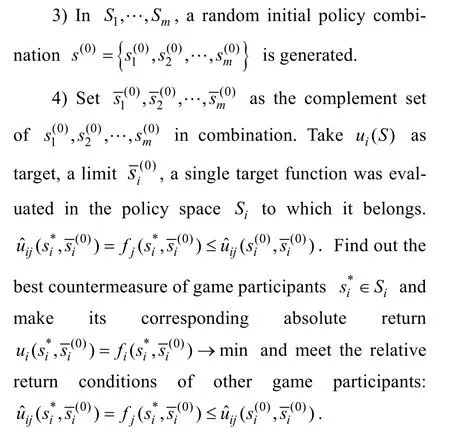
5) Make the new strategy combinationverify the feasibility of(1)s , if not meet the relative return conditions of other game participants, then go to step 2). If the relative return conditions of other game participants are satisfied, the distance (norm) of strategy combination between the front and back is calculated, and determine whether the convergence criterionis satisfied, if the convergence judgment criterion is satisfied, then the game ends; otherwise, a new game loop is carried out by replacing s(1)into s(0)and turning to step 3).
4 Calculation Results and Experimental Analysis
To fully verify the application of competitive cooperative game method in intelligent vehicle path tracking proposed in this paper, this paper combines FORTRAN and MATLAB software to verify the simulation, and the parameters of intelligent vehicle are shown in Table 1.
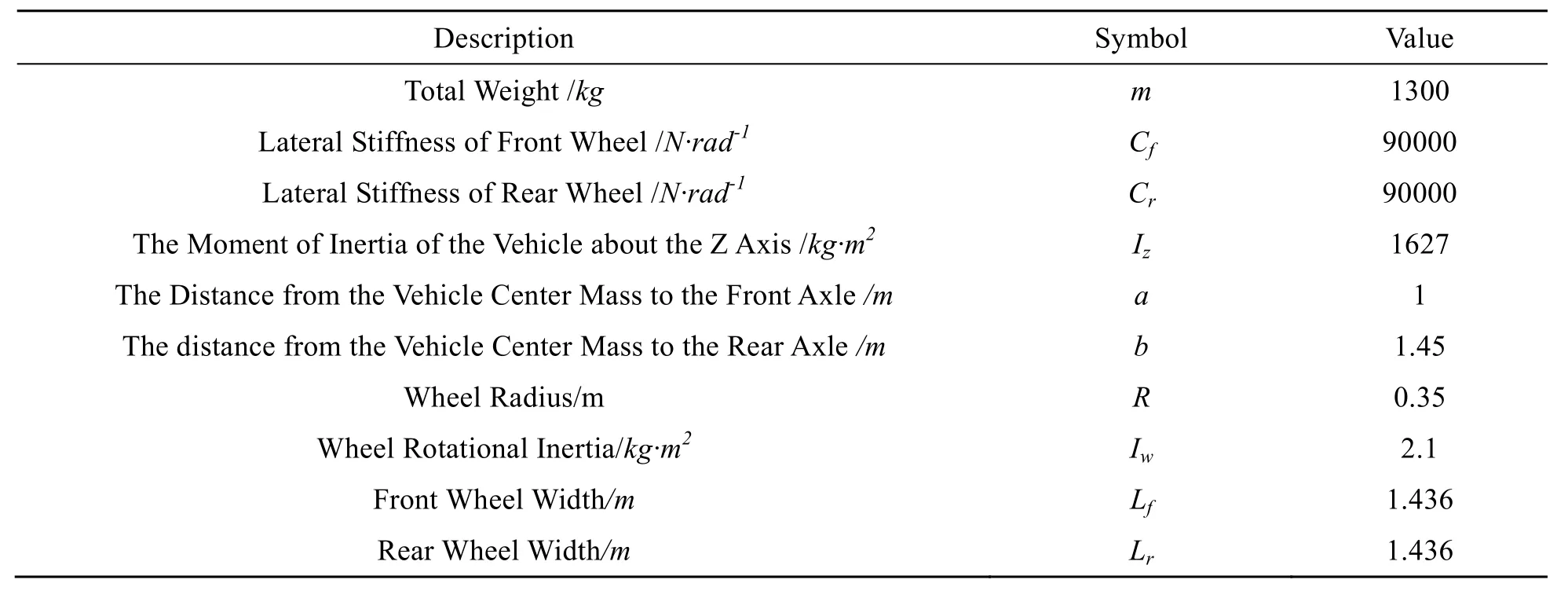
Table 1 Intelligent Vehicle Parameters
4.1 Comparison and Analysis of Calculation Results
In this paper, the double shift trajectory at three kinds of speed of 30km/h, 60km/h, and 80km/h is tracked and verified, theNpis set to 20, theNcis set to 5, and the simulation results are shown in Fig.2-7.
Compared with the simulation results of Fig.2-7, it can be seen that when the speed is low, the competitivecooperative game algorithm can realize the tracking reference path well, the transverse pendulum angle can track the expectation well, the variation of slip angle,the transverse pendulum angle velocity, the front wheel angle control amount and the incremental control are all in the controllable range. When the speed is 80km/h,the path tracking shows a large deviation, the main reason is that with the increase of the speed, the lateral acceleration is increased, resulting in the lateral deflection of the tire nonlinear, in the following research,the yaw force can be introduced to control the yaw angular velocity of vehicles, to achieve high-speed tracking.
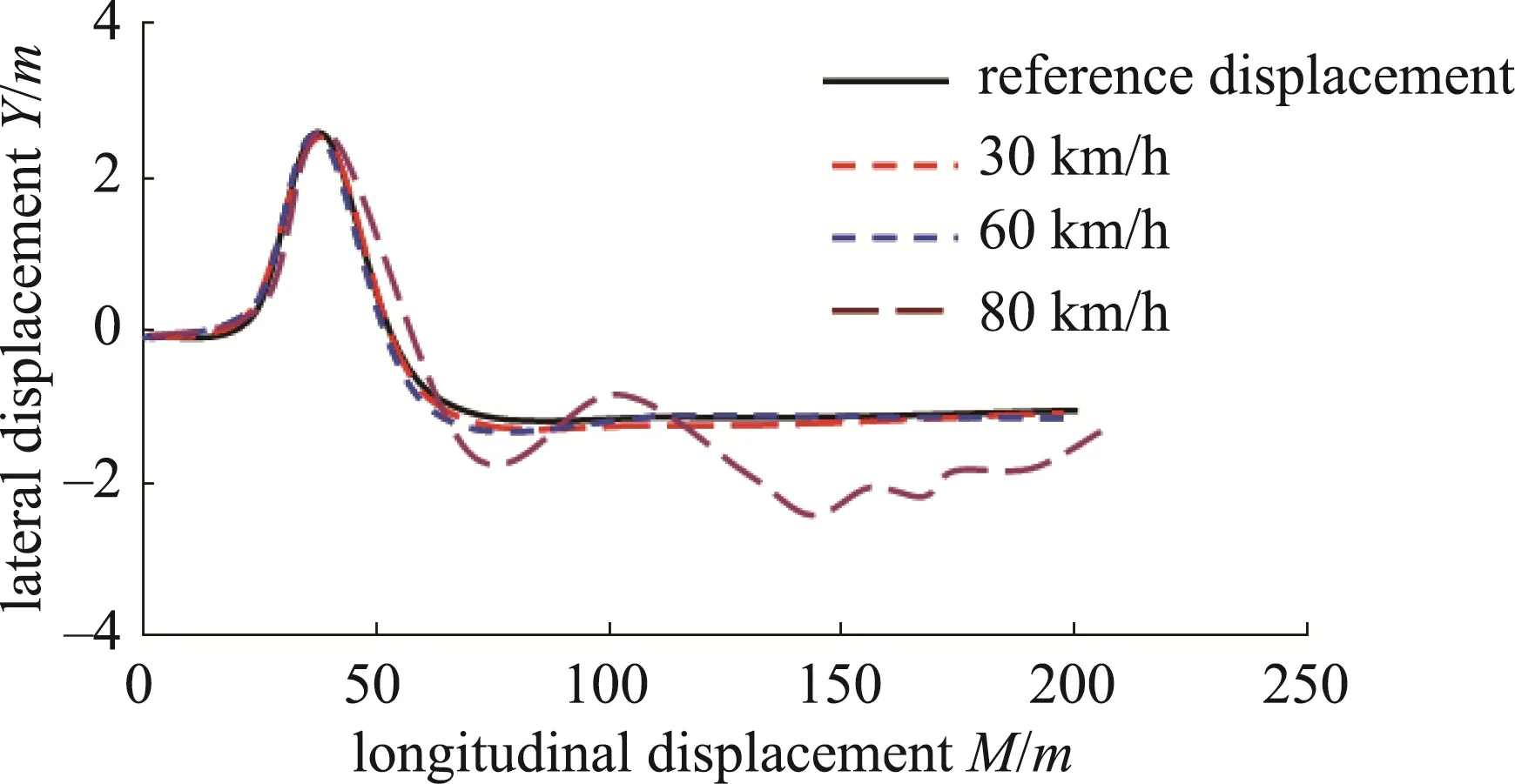
Fig.2 The Comparison of Actual Lateral Displacement
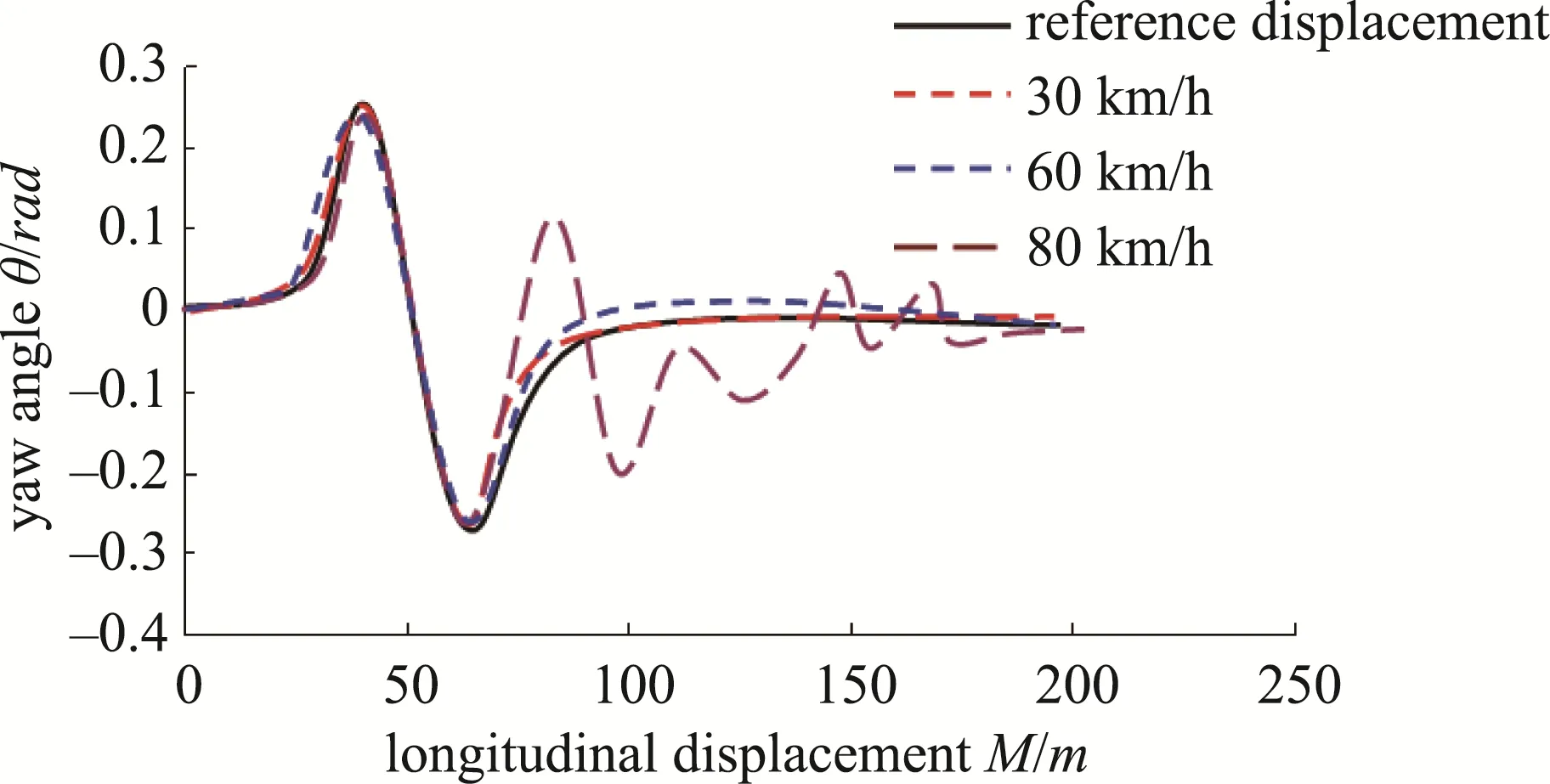
Fig.3 The Comparison of Yaw Angle

Fig.4 The Comparison of Side-slip Angle
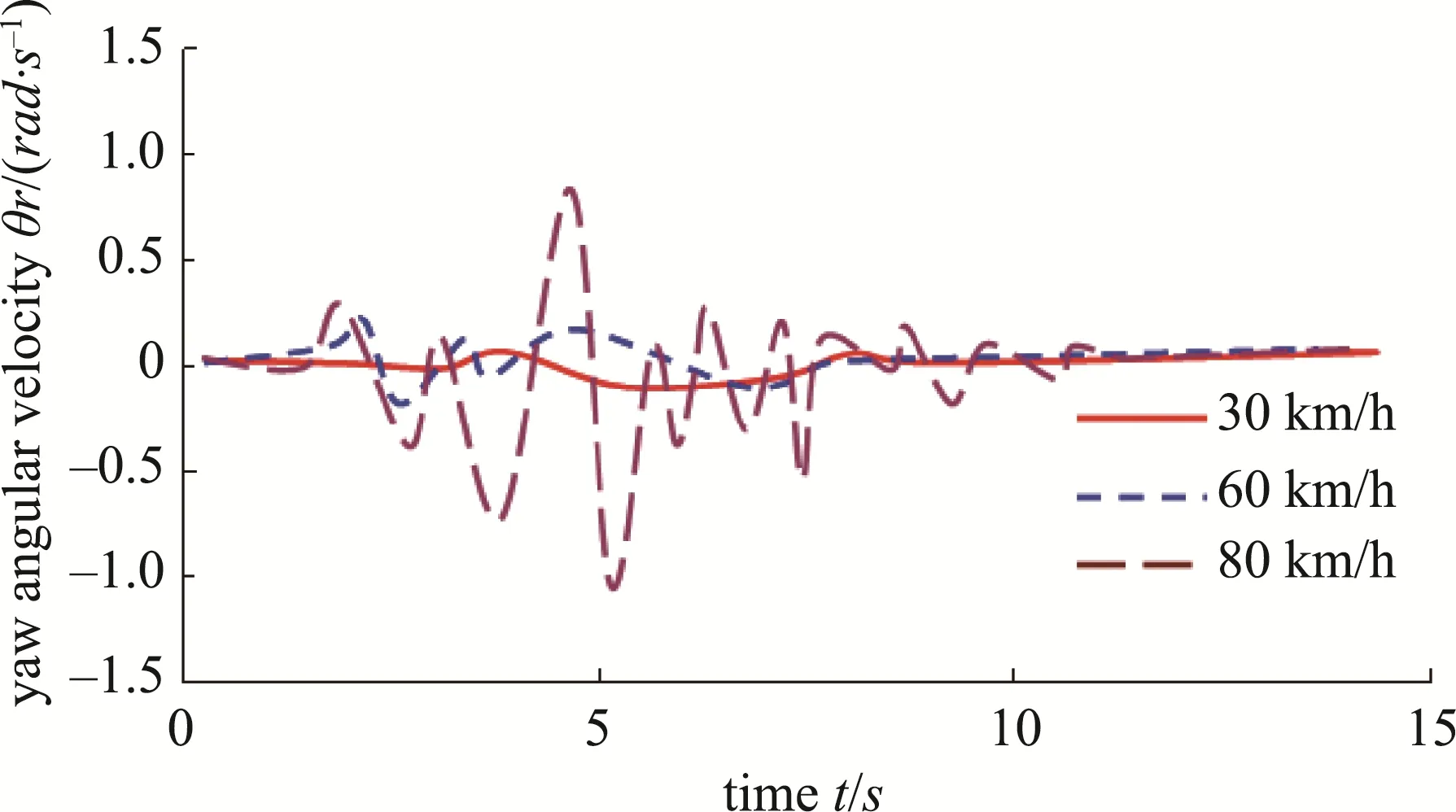
Fig.5 The Comparison of Yaw Angular Velocity

Fig.6 The Comparison of Front Wheel Angle Control
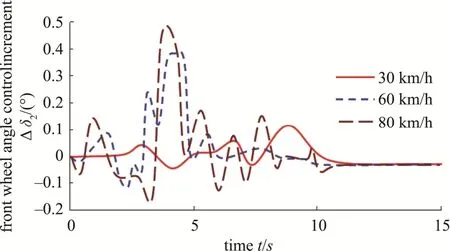
Fig.7 The Comparison of Front Wheel Angle Control Increment
4.2 Comparative Analysis of Vehicle Experiments
Through partial replacement of the experimental retrofit vehicle and body quality adjustment, the asphalt tarmac surface is used as the test pavement,using the CA-YD-103 model acceleration sensor, the speed meter (as shown in Fig.9), the VG400CC-200 all-solid-state vertical gyroscope (as shown in Fig.10),The data is obtained through the WAVEBOOK/512H high-speed portable data acquisition system of American QUATRONIX company, and the data acquisition device is shown in Fig.11, and the platform hardware controller (ECU) integrates sensors, racks and other related equipment through the LMS SCADAS multi-channel data acquisition system.Using CAN bus to debug and compile the program online.

Fig.8 Vehicle Speed Meter
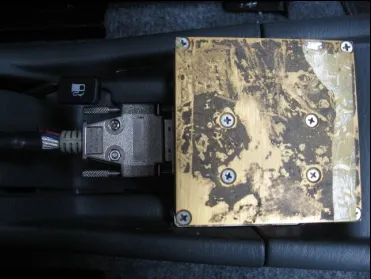
Fig.9 VG Gyroscope
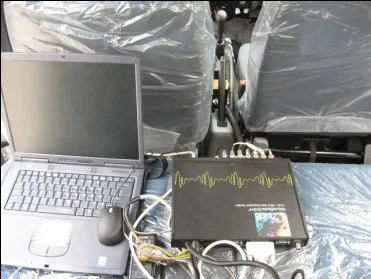
Fig.10 Data Acquisition Device WAVEBOOK
Fig.11 shows the driving trajectory of the test vehicles at different speeds, as can be seen from Fig.11,when the speed is driven under the conditions of 30km/h and 60km/h, the controller can achieve the target path tracking very well, when driving at 80km/h speed, due to the large speed caused by the phenomenon of sideslip, but in the end can still drive smoothly,The driving status of the vehicle is controllable.
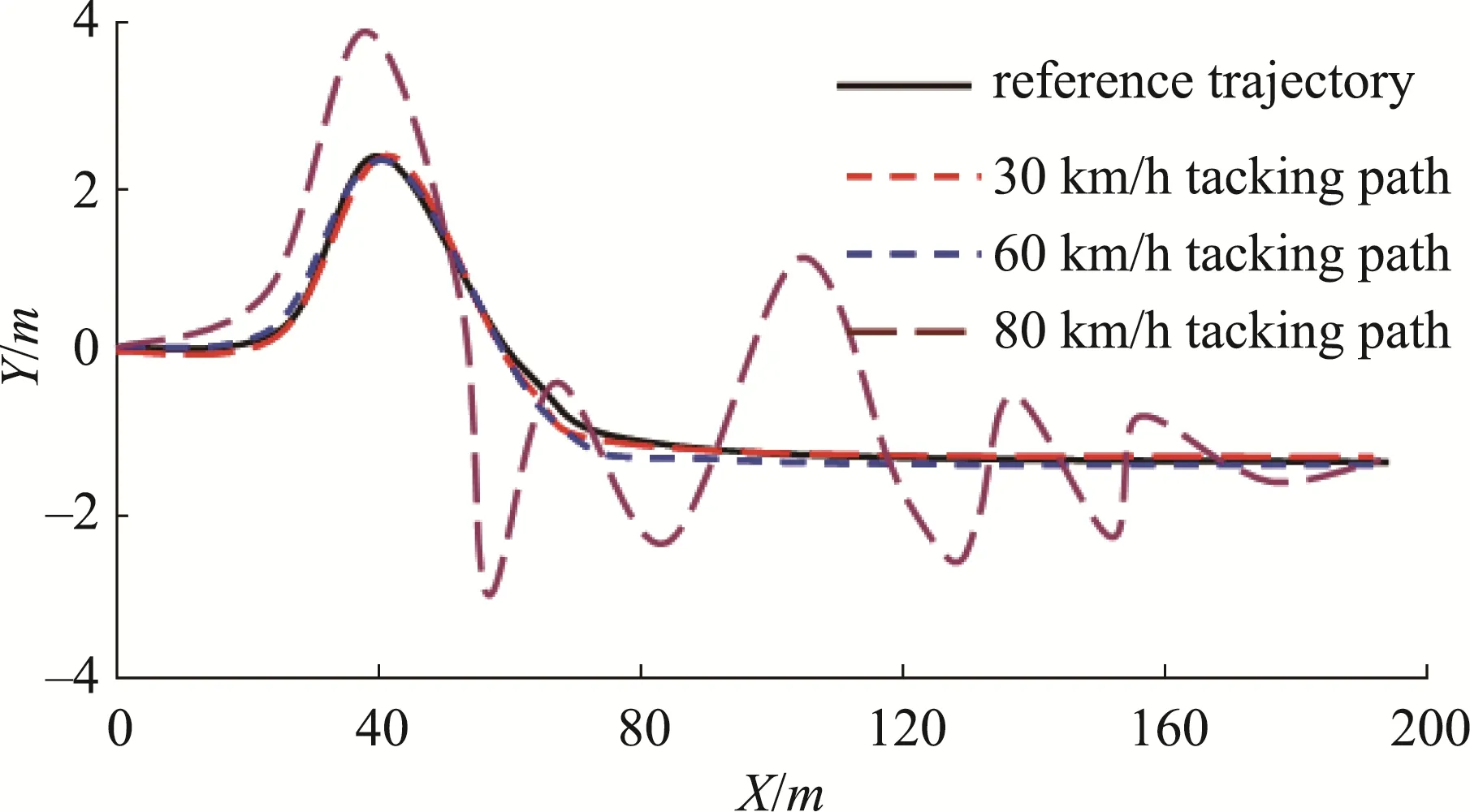
Fig.11 The Comparison of Vehicle Trajectories
5 Conclusion
To improve the driverless performance of vehicles, avoid the sideslip of vehicles in target path tracking, using the four-wheel vehicle model after linearization as the tracking control model, a method of intelligent vehicle target path tracking based on competitive cooperative game is proposed. Combining the constraint relationship between front wheel deflection angle, side deflection increment constraint, and tire side deflection dynamics, taking the path tracking state model in time domain as the objective function, the competitive cooperative game method is used to simulate, and the simulation results show the validity of the algorithm. Combined with the experimental modification vehicle, the experimental results show that the method can track the intelligent vehicles quickly and stably, the distance deviation and azimuth deviation are in a reasonable range with a good real-time performance, which provides a new research method for the target path tracking of intelligent vehicles.
Acknowledgment
Project was supported by The Natural Science Foundation of China (Grant No. 51275002).
杂志排行
Instrumentation的其它文章
- Non-destructive Testing Method for Crack Based on Diamond Nitrogen-vacancy Color Center
- Time Symmetry Analysis of Nonlinear Parity Based on S-P Compensation Network Structure
- Research on Surface Defect Detection Technology of Wind Turbine Blade Based on UAV Image
- Research on Hand-eye Calibration Technology of Visual Service Robot Grasping Based on ROS
- Iris Segmentation Based on Matting
- Design of a Logistics Automated Guided Vehicle
